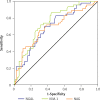Urinary neutrophil gelatinase-associated lipocalin, kidney injury molecule-1, N-acetyl-β-D-glucosaminidase levels and mortality risk in septic patients with acute kidney injury
- PMID: 30393493
- PMCID: PMC6209703
- DOI: 10.5114/aoms.2018.79006
Urinary neutrophil gelatinase-associated lipocalin, kidney injury molecule-1, N-acetyl-β-D-glucosaminidase levels and mortality risk in septic patients with acute kidney injury
Abstract
Introduction: The aim of the study was to confirm whether higher levels of urinary neutrophil gelatinase-associated lipocalin (NGAL), kidney injury molecule-1 (KIM-1) and N-acetyl-β-D-glucosaminidase (NAG) are associated with mortality risk scores in severe septic patients with acute kidney injury (AKI).
Material and methods: A prospective observational study was performed in an adult critical care unit. A total of 135 patients were included. The levels of urinary NGAL, KIM-1 and NAG were compared between patients with acute physiology and chronic health evaluation (APACHE II) score > 25 (group A, n = 31) and APACHE II score ≤ 25 (group B, n = 104).
Results: Median level of NGAL was 105.1 ng/ml (77.6-132.5) in group A versus 40.0 ng/ml (18.6-60.5) in group B (p < 0.001), KIM-1 was 16.2 ng/ml (10.2-22.3) versus 3.3 ng/ml (1.8-4.6) (p < 0.001), and NAG was 32.0 U/l (17.5-46.4) versus 15.0 U/l (7.7-22.3) (p < 0.001). The area under the receiver operating characteristic curve for NGAL was 0.70 (95% CI: 0.60-0.79), KIM-1 was 0.75 (95% CI: 0.66-0.83), and NAG was 0.69 (95% CI: 0.60-0.79). A NGAL level > 102.5 ng/ml had 95% sensitivity and 76% specificity, KIM-1 > 7.3 ng/ml had 96% sensitivity and 61% specificity, and NAG > 15.4 U/l had 86% sensitivity and 74% specificity.
Conclusions: In severe septic AKI patients, high levels of NGAL, KIM-1 and NAG are associated with mortality risk scores. Urinary NGAL, KIM-1 and NAG concentrations higher than 102.5 ng/ml, 7.3 ng/ml and 15.4 U/l respectively may be used to predict increased of death risk scores.
Keywords: N-acetyl-β-D-glucosaminidase; acute kidney injury; kidney injury molecule-1; neutrophil gelatinase-associated lipocalin; sepsis.
Conflict of interest statement
The authors declare no conflict of interest.
Figures


Similar articles
-
Diagnostic performance of urinary kidney injury molecule-1 and neutrophil gelatinase-associated lipocalin for acute kidney injury in an obstructive nephropathy patient.Nephrology (Carlton). 2014 Apr;19(4):186-94. doi: 10.1111/nep.12173. Nephrology (Carlton). 2014. PMID: 24165570
-
Performance of urinary kidney injury molecule-1, neutrophil gelatinase-associated lipocalin, and N-acetyl-β-D-glucosaminidase to predict chronic kidney disease progression and adverse outcomes.Braz J Med Biol Res. 2017 Mar 30;50(5):e6106. doi: 10.1590/1414-431X20176106. Braz J Med Biol Res. 2017. PMID: 28380198 Free PMC article.
-
Urinary calprotectin, kidney injury molecule-1, and neutrophil gelatinase-associated lipocalin for the prediction of adverse outcome in pediatric acute kidney injury.Eur J Pediatr. 2017 Jun;176(6):745-755. doi: 10.1007/s00431-017-2907-y. Epub 2017 Apr 14. Eur J Pediatr. 2017. PMID: 28409285 Clinical Trial.
-
Biomarkers for the diagnosis of sepsis-associated acute kidney injury: systematic review and meta-analysis.Ann Palliat Med. 2021 Apr;10(4):4159-4173. doi: 10.21037/apm-20-1855. Epub 2021 Mar 22. Ann Palliat Med. 2021. PMID: 33832292
-
New Biomarkers in Early Diagnosis of Acute Kidney Injury in Children.Avicenna J Med Biotechnol. 2022 Oct-Dec;14(4):264-269. Avicenna J Med Biotechnol. 2022. PMID: 36504568 Free PMC article. Review.
Cited by
-
Clinical value of serum miR-320-3p expression in predicting the prognosis of sepsis-induced acute kidney injury.J Clin Lab Anal. 2022 May;36(5):e24358. doi: 10.1002/jcla.24358. Epub 2022 Mar 25. J Clin Lab Anal. 2022. PMID: 35334494 Free PMC article.
-
Pretreatment with S-Nitrosoglutathione Attenuates Septic Acute Kidney Injury in Rats by Inhibiting Inflammation, Oxidation, and Apoptosis.Biomed Res Int. 2021 Feb 1;2021:6678165. doi: 10.1155/2021/6678165. eCollection 2021. Biomed Res Int. 2021. PMID: 33604382 Free PMC article.
-
The Effect of Dexmedetomidine on the Prognosis of Mechanically Ventilated Patients with Sepsis: A Meta-Analysis of Randomized Controlled Trials.Iran J Public Health. 2022 Oct;51(10):2171-2180. doi: 10.18502/ijph.v51i10.10976. Iran J Public Health. 2022. PMID: 36415793 Free PMC article. Review.
-
Role of the Furosemide Stress Test in Renal Injury Prognosis.Int J Mol Sci. 2020 Apr 27;21(9):3086. doi: 10.3390/ijms21093086. Int J Mol Sci. 2020. PMID: 32349337 Free PMC article. Review.
-
Evaluation of the Effect of N-acetylcysteine in the Prevention of Colistin Nephrotoxicity in Critically Ill Patients: A Randomized Controlled Trial.J Res Pharm Pract. 2025 Mar 11;13(3):85-91. doi: 10.4103/jrpp.jrpp_55_24. eCollection 2024 Jul-Sep. J Res Pharm Pract. 2025. PMID: 40275970 Free PMC article.
References
-
- Uchino S, Kellum JA, Bellomo R, et al. Acute renal failure in critically ill patients: a multinational, multicenter study. JAMA. 2005;294:813–8. - PubMed
-
- Wald R, Quinn RR, Luo J, et al. Chronic dialysis and death among survivors of acute kidney injury requiring dialysis. JAMA. 2009;302:1179–85. - PubMed
-
- Haase M, Bellomo R, Devarajan P, et al. Accuracy of neutrophil gelatinase-associated lipocalin (NGAL) in diagnosis and prognosis in acute kidney injury: a systematic review and meta-analysis. Am J Kidney Dis. 2009;54:1012–24. - PubMed
-
- Fan H, Zhao Y, Zhu JH, Song FC. Urine neutrophil gelatinase-associated lipocalin in septic patients with and without acute kidney injury. Ren Fail. 2014;36:1399–403. - PubMed
LinkOut - more resources
Full Text Sources
Miscellaneous
